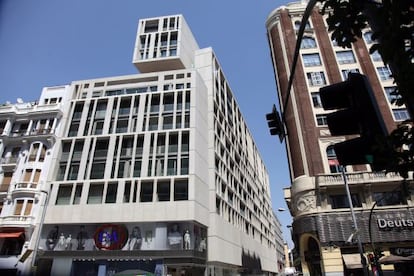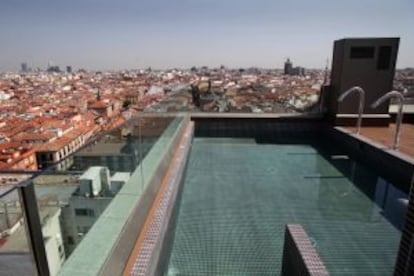Gran Vía gets a blast of modernity
The first new building for 70 years opens on Madrid’s main thoroughfare Luxury apartments include home automation systems and mechanical parking

Madrid’s Gran Vía has once again been made whole. The capital’s main thoroughfare — the city’s answer to Broadway, Regent Street and the Champs-Élysées, all rolled into one — was left with a huge vacant lot in 2011, when the headquarters of the Banco Atlántico, at number 48 by Callao plaza, was demolished. For the first time since 1932, work began on a new building on the iconic street.
Fashion store C&A has occupied the first three floors of the 13-story, 45-meter-high building since May, and in October, the remainder of the building — comprising 97 luxury apartments — officially opens.
Spanish architect Rafael de la Hoz says that his main challenge in designing the building, which is clad in stone and glass, was to balance modernity with discretion.
“We definitely didn’t want to attract attention. You have to remember that all the buildings in the Gran Vía were built over a short period of time: 20 years, between 1910 and the early 1930s, so all the buildings along it are architecturally similar in style. The job was made more demanding by location: we are right in front of the Capitol cinema, one of the Gran Vía’s most emblematic buildings, so we had to be especially considerate,” he explains.
All of the Gran Vía was built over just 20 years up to the early 1930s"
Work on the avenue began on April 4, 1910, under the reign of King Alfonso XIII, who wanted to make Madrid one of the great capitals of Europe, rivaling Paris and London. Hundreds of houses were demolished to create the broad boulevard, which traverses Madrid and connects the old and new parts of the city. In 2010 King Juan Carlos and Queen Sofía unveiled a bronze and aluminum plaque on the 1.3-kilometer avenue to mark the street’s centenary.
De la Hoz, whose other recent works in the capital include a hospital and a university, also faced another major challenge: the site is at the beginning of the Gran Vía’s half-kilometer descent down to Plaza de España, and its next-door neighbor up the hill is the 58-meter-high sprawl of the Palacio de la Prensa. To help the building fit in, he says that he decided to use terracing to create a staircase effect that leads the eye down toward Plaza de España. The stone facing was originally going to be of the same type used on most of the other buildings on Gran Vía, says De la Hoz, “but the owners, who later did much of the work on the interior, wanted to use granite from Galicia.”
The building boasts a roof-top swimming pool, a solarium, a gym and a sauna, and offers a range of properties, from 50-square-meter studios, up to a 310-square-meter, four-bedroom duplex. Prices run from 500,000 up to three-million euros.
The company behind the project is A Coruña-based Valmarcasa Constructores-Promotores. Rafael Vázquez, the head of the works, says that half of the properties have already been sold. No expense has been spared, Vázquez explains. “Even the doorhandles have been specially designed, and the taps cost more than 300 euros a set. The showers are solid marble, and the fire doors and safety features are the best and most up-to-date on the market,” he says.
Vázquez explains that buyers like the idea of living in the heart of the city, and that Gran Vía needs to attract more residents. For many years, the streets behind the thoroughfare were allowed to deteriorate and the area was a well-known center for prostitution and seedy sex clubs. But a major clean-up operation has been underway for the last decade, with bars, restaurants and fashion stores gradually taking over what is, after all, an enviably central location.

The presence of Dutch fashion retailer C&A at street level reflects the change that Gran Vía has undergone over the last decade. For most of its lifetime, shops were a discreet presence, and the street was lined instead with huge cafés and cinemas. But chain stores belonging to the Inditex empire, such as Zara, are slowly taking over.
Meanwhile, at number 48, workers continue to put the finishing touches to the interiors: wardrobes and shelving have now been delivered, and the home automation systems in the pilot apartment are now fully functioning, controlling lights, blinds and air-conditioning — even the automatic vacuum cleaners are all installed and working. Parking, as much a nightmare in central Madrid as in any other major city, has also been taken care of. Underneath the building is an automated garage system occupying eight floors. Residents simply leave the vehicle on a platform at ground level, punch in a number, and the car disappears into the bowels of the city. The car park will also be available for occupants of neighboring buildings.
“This is the corner spot that everybody wants,” says Vázquez looking out from the duplex’s terrace over the rooftops to the old clock atop the headquarters of the regional government of Madrid in the Puerta del Sol. “On New Year’s Eve, the lucky owners of the terrace will be able to see the clock hit midnight, and then enjoy the Madrid tradition of eating 12 grapes, one for each chime, and then of course toast with bubbly.”
Tu suscripción se está usando en otro dispositivo
¿Quieres añadir otro usuario a tu suscripción?
Si continúas leyendo en este dispositivo, no se podrá leer en el otro.
FlechaTu suscripción se está usando en otro dispositivo y solo puedes acceder a EL PAÍS desde un dispositivo a la vez.
Si quieres compartir tu cuenta, cambia tu suscripción a la modalidad Premium, así podrás añadir otro usuario. Cada uno accederá con su propia cuenta de email, lo que os permitirá personalizar vuestra experiencia en EL PAÍS.
¿Tienes una suscripción de empresa? Accede aquí para contratar más cuentas.
En el caso de no saber quién está usando tu cuenta, te recomendamos cambiar tu contraseña aquí.
Si decides continuar compartiendo tu cuenta, este mensaje se mostrará en tu dispositivo y en el de la otra persona que está usando tu cuenta de forma indefinida, afectando a tu experiencia de lectura. Puedes consultar aquí los términos y condiciones de la suscripción digital.








































